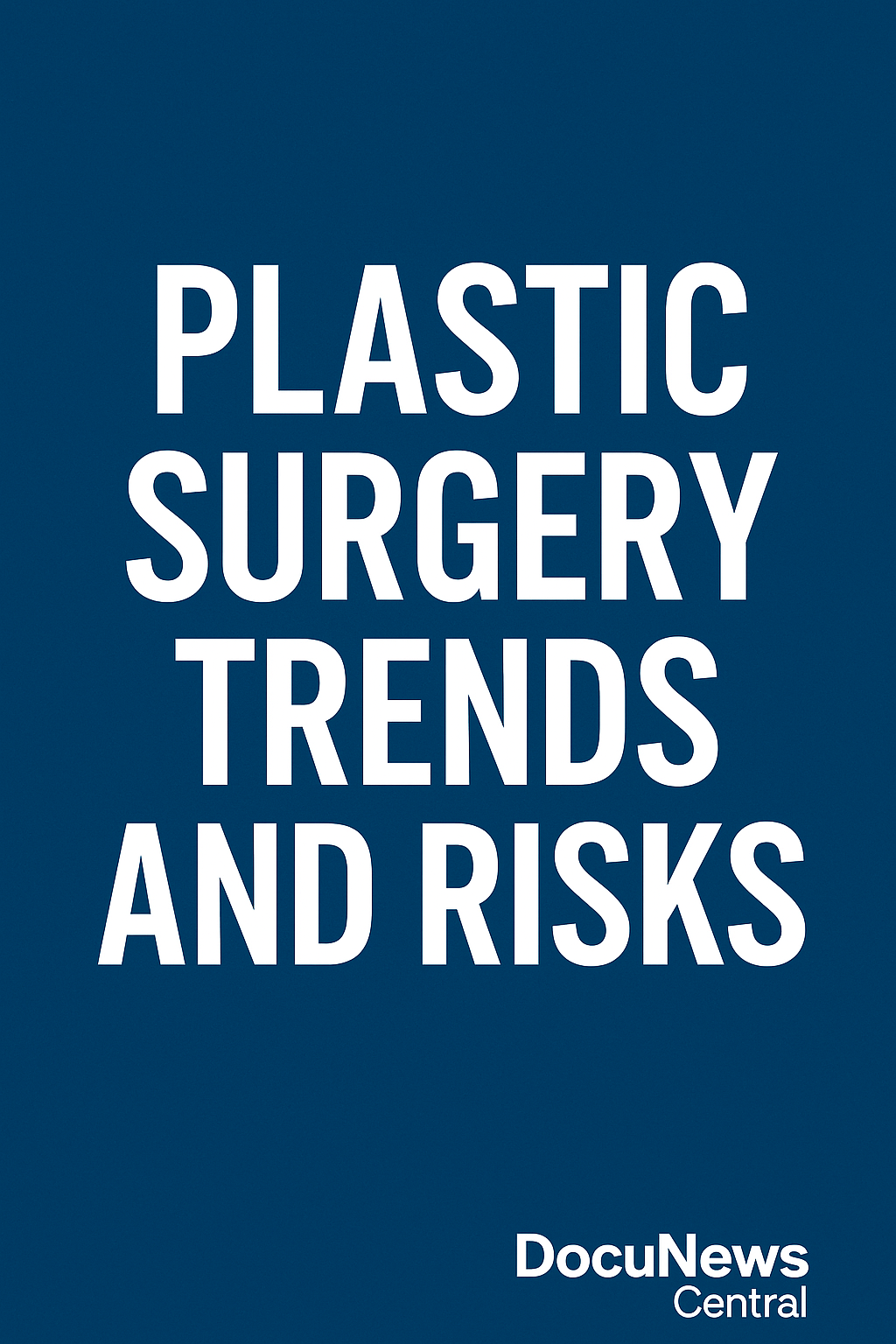

Plastic surgery has become one of the fastest-growing sectors in the global healthcare and beauty industry. With increasing awareness of physical appearance and the influence of social media, more people are turning to cosmetic and reconstructive procedures to enhance their looks. However, while the demand for plastic surgery continues to rise, it is important to understand not only the trends but also the risks associated with these procedures.
In this comprehensive blog post, we will explore the latest plastic surgery trends, the driving forces behind their popularity, and the risks patients should carefully consider before making a decision.
The Rise of Plastic Surgery Globally
Plastic surgery has shifted from being a luxury procedure for celebrities and wealthy individuals to becoming a more accessible option for the middle class. In fact, according to the International Society of Aesthetic Plastic Surgery (ISAPS), millions of cosmetic procedures are performed worldwide each year.
Furthermore, technological advances and minimally invasive techniques have reduced recovery times, making surgery less intimidating. Additionally, financing options and medical tourism have made it easier for more people to afford such treatments.
Consequently, the rise of plastic surgery can be linked to cultural acceptance, medical innovation, and affordability.
Most Popular Plastic Surgery Procedures
Plastic surgery trends change over time, often influenced by celebrities, beauty standards, and medical advancements. Let us examine the most sought-after procedures today.
1. Liposuction
Liposuction remains one of the top cosmetic procedures globally. It involves removing excess fat from specific areas of the body to achieve a slimmer, more contoured appearance. While it is not a weight-loss method, it is highly effective in reshaping stubborn areas such as the abdomen, thighs, and arms.
2. Breast Augmentation and Reduction
Breast surgeries, including augmentation (implants), reduction, and lifts, are consistently in demand. Many women opt for these procedures to enhance their figure, correct asymmetry, or relieve discomfort caused by overly large breasts.
3. Rhinoplasty
Commonly known as a “nose job,” rhinoplasty is popular among both men and women. People pursue it for cosmetic enhancement or to correct breathing issues. The procedure has been revolutionized by advanced techniques that provide natural-looking results.
4. Botox and Fillers
Non-surgical cosmetic procedures like Botox injections and dermal fillers dominate the beauty industry. They provide quick, minimally invasive ways to reduce wrinkles, enhance lips, and restore facial volume without requiring surgery.
5. Facelifts and Neck Lifts
As people live longer and desire a youthful appearance, facelifts and neck lifts remain popular. These procedures tighten sagging skin and restore a firmer, rejuvenated look.
6. Brazilian Butt Lift (BBL)
This trend has gained massive attention, particularly due to social media influencers. A Brazilian Butt Lift involves transferring fat from one area of the body to the buttocks, enhancing shape and volume.
7. Tummy Tuck (Abdominoplasty)
A tummy tuck is widely sought after by individuals who have undergone significant weight loss or pregnancy. It removes excess skin and fat while tightening abdominal muscles.
Clearly, the diversity of procedures reflects changing beauty ideals and evolving patient demands.
Why Plastic Surgery Trends Keep Changing
Plastic surgery trends do not remain constant. Instead, they evolve alongside cultural, technological, and social developments. Several factors contribute to these shifts.
- Celebrity and Influencer Culture: Celebrities and online influencers significantly shape what is considered “beautiful.”
- Social Media and Filters: Platforms like Instagram and TikTok promote edited appearances, increasing the desire for cosmetic enhancement.
- Technological Innovations: As safer, faster, and less invasive procedures emerge, more patients are encouraged to undergo treatments.
- Medical Tourism: Countries such as Turkey, Thailand, and Mexico attract patients with affordable yet advanced cosmetic surgery, fueling the global market.
- Psychological Factors: The desire to boost self-confidence and improve mental well-being also drives people toward plastic surgery.
Thus, the changing landscape of beauty ensures that plastic surgery trends will always shift.
Potential Risks of Plastic Surgery
Although plastic surgery can produce life-changing results, it is not without risks. Understanding these dangers is essential before undergoing any procedure.
1. Surgical Complications
As with any surgery, there is always a risk of infection, bleeding, and complications related to anesthesia. Even when procedures are performed by professionals, no surgery is entirely risk-free.
2. Scarring and Poor Healing
Plastic surgery may leave permanent scars, particularly if post-operative care is not followed. Some patients also experience delayed healing due to underlying health conditions.
3. Dissatisfaction with Results
Not all patients achieve their desired look. In some cases, results may appear unnatural, or expectations may not align with reality. This often leads to regret and the pursuit of corrective surgeries.
4. Nerve Damage
Nerve injury is a possible risk, particularly in facial surgeries. Some patients report numbness, tingling, or even loss of sensation in the affected area.
5. Financial Burden
Plastic surgery is often expensive. While financing options exist, patients may underestimate the long-term costs of follow-up treatments, corrections, or complications.
6. Mental and Emotional Effects
Although many people undergo surgery to boost confidence, some may struggle with body dysmorphia or depression after surgery. Unrealistic expectations can result in disappointment and low self-esteem.
7. Life-Threatening Risks in Certain Procedures
High-risk surgeries, such as the Brazilian Butt Lift, have been associated with higher fatality rates due to fat embolism (fat entering the bloodstream). Choosing unqualified surgeons increases these risks significantly.
Consequently, while the benefits of plastic surgery are appealing, patients must weigh them carefully against potential dangers.
How to Reduce Risks Before Surgery
Fortunately, patients can minimize risks by taking certain precautions.
- Choose a Certified Surgeon: Always ensure the surgeon is board-certified and experienced in the procedure you are considering.
- Research the Procedure: Understanding the steps, recovery time, and possible complications can help set realistic expectations.
- Have a Medical Evaluation: Discuss your health history and undergo necessary tests to determine if you are a good candidate.
- Follow Pre- and Post-Surgery Instructions: Proper preparation and aftercare significantly improve healing and results.
- Avoid Unrealistic Expectations: Cosmetic surgery can enhance appearance but will not fix deeper emotional or psychological issues.
By making informed decisions, patients can increase their chances of achieving safe and satisfactory outcomes.
Non-Surgical Alternatives to Plastic Surgery
Not everyone is ready to undergo surgery, which is why non-surgical alternatives are gaining traction. These procedures are less invasive, require minimal recovery time, and carry fewer risks. Some popular non-surgical options include:
- Laser Treatments: Used for skin resurfacing, hair removal, and scar reduction.
- Ultherapy and Radiofrequency: Non-invasive treatments that tighten skin and stimulate collagen production.
- Chemical Peels: Improve skin tone and reduce signs of aging without surgery.
- Cryolipolysis (CoolSculpting): A fat-freezing technique that eliminates stubborn fat cells without invasive surgery.
Therefore, for individuals concerned about the risks of surgery, non-surgical methods offer effective alternatives.
Plastic Surgery and Ethical Concerns
Beyond medical and physical risks, plastic surgery also raises important ethical questions.
- Age Restrictions: Should teenagers be allowed to undergo procedures influenced by temporary beauty trends?
- Advertising Pressure: Many clinics use aggressive marketing to target vulnerable individuals.
- Body Image Issues: Relying heavily on surgery may reinforce harmful beauty standards and increase mental health struggles.
Hence, patients, families, and healthcare providers must consider ethical implications before approving certain procedures.
The Future of Plastic Surgery
Looking ahead, plastic surgery is expected to evolve in remarkable ways. Innovations such as robotic-assisted surgery, regenerative medicine, and stem cell applications are already being explored. Additionally, 3D imaging and virtual reality simulations are helping patients preview results before surgery.
As procedures become safer and more precise, demand is likely to continue growing. However, so will the conversations about health, safety, and self-acceptance.
Conclusion: Balancing Beauty and Safety
Plastic surgery is undeniably transforming the way people view beauty and self-confidence. From liposuction to Botox, trends continue to rise as technology advances and cultural influences shape demand. However, behind the promise of enhancement lies a range of risks that must never be ignored.
Therefore, anyone considering plastic surgery should make informed choices, consult certified surgeons, and maintain realistic expectations. Ultimately, true beauty is not only about physical appearance but also about health, confidence, and self-acceptance.
This is DocuNews Central Reporting. Please subscribe for more.






